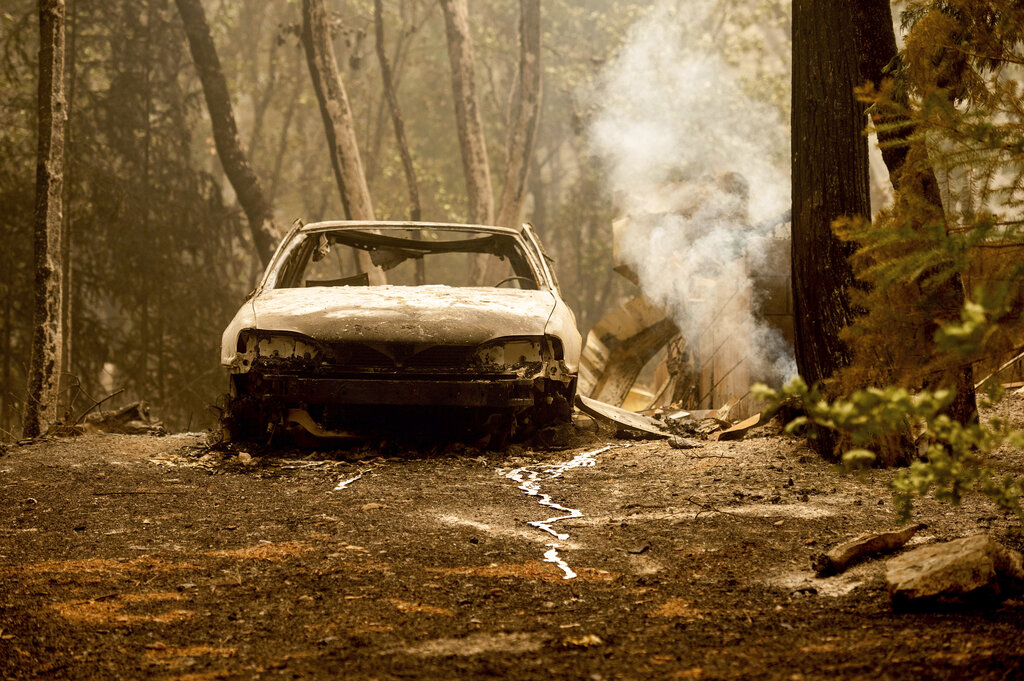Winds drive California’s largest fire as West burns

FILE – In this Saturday, July 24, 2021, file photo a firefighter passes a burning home as the Dixie Fire flares in Plumas County, Calif. The fire destroyed multiple residences as it tore through the Indian Falls community. Erratic winds and the potential for dry lightning added to the challenges facing firefighters battling California’s largest wildfire, one of numerous blazes burning Monday across the U.S. West. (AP Photo/Noah Berge,File)
INDIAN FALLS, Calif. (NewsNation Now) — The delay before officials will be able to assess the damage done to a small town by California’s largest wildfire could stretch to days. The culprit is the Dixie Fire, one of dozens scorching lands across the U.S. West.
Over the weekend, the colossal blaze roared through the remote Northern California community of Indian Falls. At least 16 houses and various other buildings had already burned, but fresh flames kept officials from giving a new damage estimate Monday.
“Fire behavior has been so unpredictable, it hasn’t been safe for inspectors to go in to work,” said fire spokesman Mitch Matlow. “Until things settle down, we won’t know the extent of what’s burned.”
Firefighters working in the steep, remote terrain faced additional dangers of erratic winds and the potential for dry lightning. Gusts also hindered containment efforts, and the problem could get worse with the predicted arrival of pyrocumulus clouds — literally meaning “fire clouds ” — which can bring lightning and the risk of new fires.
In Plumas and Butte counties, fire officials said the blaze had charred more than 197,000 acres of timber and brush. It was 22% contained Monday, with more than 10,000 homes still in danger.
The news is slightly better with the nation’s largest wildfire, the Bootleg Fire in southern Oregon, where authorities hope improving weather will help continuing containment efforts. It was just over half contained after chewing through more than 409,000 acres of remote land.
The lightning-caused fire has burned at least 70 homes, leaving some 2,000 residences still under evacuation orders.
After being overrun last week by a Montana wildfire, four firefighters were released from a hospital while a fifth remained in a burn center Monday, according to authorities. The 6,400-acre Devil’s Creek Fire was threatening Fort Peck Reservoir along the Missouri River in Garfield County. It’s one of three major fires in Montana.
Firefighters have frequently dealt with rapacious fire behavior, with conflagrations consuming huge areas of vegetation each day. Such conditions are often from a combination of unusual random, short-term and natural weather patterns heightened by long-term, human-caused climate change. Global warming has made the West much warmer and drier.
U.S. Forest Service Chief Randy Moore pointed to a recent unpredictable blaze in the Lava Beds area of California. Firefighters thought they had quenched it, only to have the fire flare up again after it burned through a system of tree roots and traveled beneath a containment line.
“It’s off the charts in terms of how some of these fires are behaving,” Moore said.
Elsewhere in California, cooler weather helped firefighters make progress on the 68,000-acre Tamarack Fire south of Lake Tahoe, which continued to burn through timber and chaparral. The fire was 54% contained and evacuation orders that affected some 2,000 residents in 15 communities on both sides of the California-Nevada state line had been lifted. Ignited by lightning July 4 in Alpine County, California, the fire has claimed at least 23 buildings, including more than a dozen in Nevada.
More than 85 large wildfires were burning across the nation, most of them in Western states. They had burned nearly 1.5 million acres.
The Associated Press contributed to this story.
Latest News
- Thune lays out plan for separate border and tax reconciliation bills
- AUTO TEST: NNN Synopsis Text
- AUTO TEST: Synopsis post
- AUTO TEST: NNN Synopsis
- AUTO TEST: Disable Ads post


















